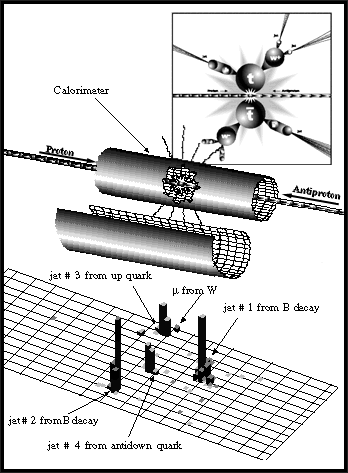Inquiring Minds
|
Physics at Fermilab main page | accelerators | collider experiments | neutrino physics | technology computing | theory | astrophysics | discoveries at Fermilab |
|||
|
|||
How can we recognize a top quark's electronic signature? Top quarks exist for such a short time that we don't actually find their signatures, but instead those of their known decay products. Here, the lego plot shows one characteristic signature pattern--called a "lepton plus jets event"--that we expect to see in a collision that produces a top-antitop quark pair. The top quarks instantly decay into two W particles and two b quarks. One W in turn decays into a muon and a neutrino, the other into up and down quarks. The up and down immediately decay into jets of particles. The b quarks travel a little way before they too decay into jets. The results of this collision are a muon, a neutrino, and four jets of particles. The lego plot identifies the muon and the four jets. The neutrino leaves no tracks; we infer its existence from missing energy in the collision results. |
| last modified 02/26/2001 email Fermilab |
FRLsDFx9eyfrPXgV



 Is it a top quark?
Is it a top quark?
